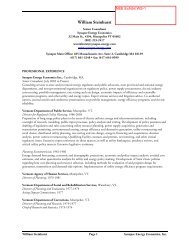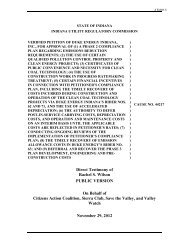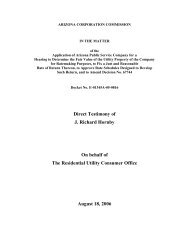Best Practices in Energy Efficiency Program Screening - Synapse ...
Best Practices in Energy Efficiency Program Screening - Synapse ...
Best Practices in Energy Efficiency Program Screening - Synapse ...
Create successful ePaper yourself
Turn your PDF publications into a flip-book with our unique Google optimized e-Paper software.
Appendix A – Illustrative Example and Avoided Costs<br />
Introduction<br />
Throughout this paper we have referenced an actual New England utility's energy<br />
efficiency programs and screen<strong>in</strong>g results, <strong>in</strong> order to demonstrate the implications of<br />
the different screen<strong>in</strong>g practices. We have relied on the same utility <strong>in</strong> each of the<br />
examples discussed <strong>in</strong> the body of the report, and have based each example on the<br />
utility’s actual efficiency programs, <strong>in</strong>clud<strong>in</strong>g its projected (or actual where pert<strong>in</strong>ent)<br />
budget, sav<strong>in</strong>gs, benefits, and other assumptions.<br />
This Appendix provides a more complete background on that utility’s efficiency<br />
programs, as well as the avoided cost assumptions <strong>in</strong>cluded <strong>in</strong> its cost-effectiveness<br />
analysis. Each of these topics is discussed <strong>in</strong> more detail below.<br />
<strong>Program</strong> Descriptions<br />
The report focuses on n<strong>in</strong>e of the utility’s programs that are common to efficiency<br />
programs <strong>in</strong> many states. This New England utility actually adm<strong>in</strong>isters more programs<br />
than those discussed <strong>in</strong> the report, such as a behavioral-based program. By restrict<strong>in</strong>g<br />
the analysis to these n<strong>in</strong>e programs, our <strong>in</strong>tention is to focus on a core set of programs<br />
that are typically offered <strong>in</strong> states, rather than provide a comprehensive analysis of<br />
program portfolios. The identified programs and a brief description of each program’s<br />
purpose are provided below.<br />
Residential Retrofit: the purpose of this program is to provide residential<br />
customers with energy efficiency recommendations that enable them to identify<br />
and <strong>in</strong>itiate the process of <strong>in</strong>stall<strong>in</strong>g cost-effective energy efficiency upgrades.<br />
The program provides <strong>in</strong>formation through outreach mechanisms, <strong>in</strong>centives, and<br />
multiple f<strong>in</strong>anc<strong>in</strong>g options.<br />
Residential New Construction: the purpose of this program is to capture lost<br />
opportunities, encourage the construction of energy-efficient homes, and drive<br />
the market to one <strong>in</strong> which new home are mov<strong>in</strong>g towards net-zero energy.<br />
Residential Appliances: the purpose of this program is to raise consumer<br />
awareness of the benefits of energy-efficient ENERGY STAR-qualified consumer<br />
products, encourage consumers to purchase qualified appliances and consumer<br />
electronics, promote higher efficiency standards for products, and to help<br />
customers reduce energy bills by replac<strong>in</strong>g or recycl<strong>in</strong>g <strong>in</strong>efficient products.<br />
Residential Light<strong>in</strong>g: the purpose of this program is to <strong>in</strong>crease consumer<br />
awareness of the importance and benefits of purchas<strong>in</strong>g ENERGY STARqualified<br />
light<strong>in</strong>g products and expand the availability, consumer acceptance, and<br />
use of high-quality energy-efficient light<strong>in</strong>g technologies and controls.<br />
Low-Income Retrofit: the purpose of this program is to deliver energy efficient<br />
products and services directly to the homes of <strong>in</strong>come eligible customers to help<br />
them lower their energy bills to achieve deeper and broader energy sav<strong>in</strong>gs.<br />
<strong>Best</strong> <strong>Practices</strong> <strong>in</strong> <strong>Energy</strong> <strong>Efficiency</strong> <strong>Program</strong> Screen<strong>in</strong>g | www.nhpci.org | 67







